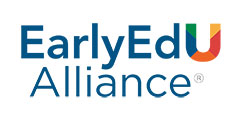Arizona State University Degree Pathways
Arizona State University Degree Pathways

Bjorg LeSeuer, clinical associate professor at Arizona State University’s Mary Lou Fulton Teachers College, knew from her first contact with the EarlyEdU Alliance in 2017 what she wanted her college’s online programs to achieve.
She wanted a seamless way for early childhood educators to earn associate and bachelor’s degrees. Phoenix Head Start had already asked the college for help with this. Community colleges and the college’s other partners also were looking for this kind of support. Most important, LeSeuer wanted to connect the faculty and students more deeply to the work early childhood professionals are doing daily. She wanted it to both honor and mobilize their experience and expertise.
Seven years and more than 120 graduates later, LeSeuer and her colleagues have met these goals. She credits EarlyEdU’s influence, approach and courses as contributors to the programs’ success. The Fulton College uses six courses from EarlyEdU. Without the Alliance and its courses, LeSeuer says, ASU wouldn’t have this type of quality program.
More than 300 students participate in the college’s two degree paths in early childhood studies: a four-year Bachelor of Arts in Education, and a two-year transfer degree in Bachelor of Applied Science in Early Childhood Studies. They connect online from throughout the country—most of the students live out of state—and they range in age from 18 to 72. An increasing share of students are seasoned educators.
“Our program has grown exponentially from just meeting the needs of the Head Start workforce to service across the 0-5 sector,” LeSeuer reports. A few students enter the program with little or no workforce experience. Others come with decades of experience in early childhood classrooms.
The key to engaging and uniting this community, LeSeuer says, is reflective practice.
“It’s not just about gathering content and telling them what you know. You do something with the content, and then you reflect on practice. If you’ve been in the classroom for 20-plus years or you’re just starting out, you have something to gain from the experience.”
The Intentional Teaching Framework offers students and teachers this experience. This iterative cycle of learning and development (know, see, do, reflect) gives structure to all EarlyEdU courses.
Another tool that supports reflective practice has been the Coaching Companion Campus Edition, a video-sharing and coaching feedback application. Through video sharing, students can review their own teaching performance and discuss it with their classmates—wherever they live. LeSeuer says video sharing and reflection are cornerstones of her work. Through this method, LeSeuer’s students can “build their professionalism and share their instruction. That piece of reflective practice is so ingrained in the EarlyEdU content.”
LeSeuer says, the video-sharing process also links students to their coursework whatever their experience level. LeSeuer has students who have been paraprofessionals for 20 years, and “you can't treat them like an 18-year-old just coming to college.” Video sharing allows her to step back from micromanagement and instead encourage students to bring whatever they have to offer into the coursework. She sees herself and other faculty as facilitators of the community that EarlyEdU courses and video-sharing have helped develop.
LeSeuer points to the challenge when students come to her program from a job as director or other management role in an early childhood program. “What can I do for a director?” she has asked herself at times. With video sharing, LeSeuer sees an opportunity to access an experienced educator’s expertise. The method shows the true challenges of introducing new strategies into the classroom, even to more experienced students. It also invites their peers to review their work and share insights and feedback. EarlyEdU courses and their video sharing element prepare students “to take the things that we're teaching them, and then think about how that applies to their work settings, or how that aligns with their experience.”
LeSeuer notes that her program stands apart from others that require students to read a chapter, take a quiz, and move to the next lesson.
“We have no quizzes, no exams. It’s all about reflection, based on the content that we’ve shared this week,” she says. The videos complement written assignments. “Often times with students, I’ll look at their writing and think they’re getting it. And then I see a video, and it falls flat,” LeSeuer says. Other times, she’ll conclude from some students’ assignments that they aren’t connecting with the course content and sharing this connection in writing. “But then they submit their videos, and they’re gorgeous.”
The video sharing has taught LeSeuer that it’s one thing to know how to show up for kids and another to articulate it in an academic way. Through video, she can better gauge students’ understanding and knowledge.
Finally, LeSeuer recognizes the “magic” of the communities of reflection and practice, within which students share their coursework, classroom performance, and feedback. “It happens when you’re submitting to a group of peers, like four or five students. And you’re talking to each other about teaching and building community,” LeSeuer says. She said reviewing their own work along with their classmates’ work unites students across their very different backgrounds and distance.
“They know each other like they’ve been together in the classroom,” she says, “and they sit together when they do meet at graduation.”
EarlyEdU Courses in Action
Learn more about the EarlyEdU courses at Arizona State University
